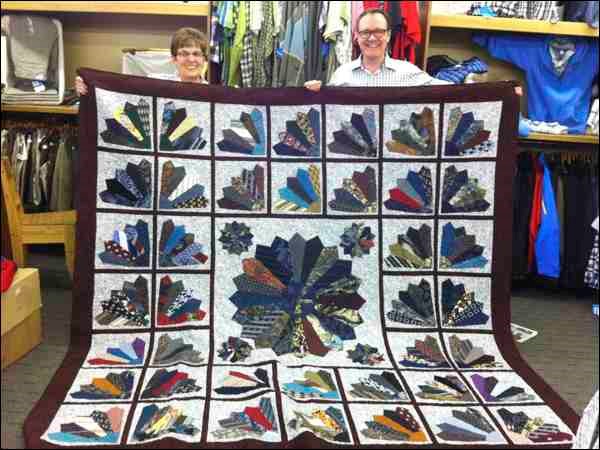Fat, skinny, silk, polyester, half-Windsor, clip-on, stripes, solids.
The man's necktie. Most men wear them at some time in their lives, some at most times in their lives.
Yet, despite the proliferation of this ubiquitous fashion staple, the origins of today's necktie cannot be exactly pinned down. Although theories abound, the most common seems to be that, in the 17th century, Louis XIV's Croatian regiment wore neck cloths that began the evolution of the modern tie.
Most men have a few ties hanging in their closet, maybe even a dozen. Ben Christensen has virtually all of the ties he's ever owned, and most of them are hanging in one spot in his store - as pieces of a giant quilt.
Christensen has been in the men's wear business since 1969 when, as a high school student, he started working at Eaton's in North Battleford. He says he's kept all his ties since then.
"They are easy to save and in many ways they are works of art," says Christensen, owner of Bill & Don's Men's Wear and Shoes in North Battleford.
He's never been able to make himself throw a tie away. Now they will always remain together, quilted by Irene Halco of Spiritwood. The central pattern, called Dresden Plate, contains Christensen's favourites. Halco, then Miss Lavoie, was Christensen's Grade 3 teacher in 1963 when his family lived in Spiritwood. His father was the station agent there for 10 years.
The idea of making the quilt came from a visit with his friend Ted Matheson of Prince Albert, also in the clothing business, whose mother-in-law had made a quilt of his ties. Having Halco make a similar quilt was a result of their many chats through the years Christensen served on the district health board, which included the Spiritwood area, and the times Halco has visited his store. When he found out she enjoyed quilting, he asked her if she was up for a challenge.
The result is an over-large quilt, bigger than any king-sized bed might accommodate. Christensen says he would like to have it displayed at the Chapel Gallery for a time, then, he says, there's a large wall in his family home that could become its permanent location.
The quilt is a look back at the ties of the last four decades. Most of them are silk, says Christensen, because silk, particularly Italian silk, remains the best fabric for producing a quality necktie.
There was a polyester era, however, in the mid-1980s, and a short-lived trend in double-knit fabric ties. Those double-knits made for large, uncomfortable knots, Christensen laughs; they didn't last long.
Then came the leather zipper ties! Young men liked them because they didn't have to tie them. The clip-on held the same attraction.
But the knotted tie endures. Even though there are several knots one might use, says Christensen, the Half-Windsor, named after the Duke of Windsor, is probably the most popular because it makes for a nice, neat triangle with a little dimple below.
As fashion has changed throughout the years, ties have accommodated those trends, varying in width, length, colour, pattern, knot and even material. Even so, the tradition of stripes, dots, paisley or a solid colour on silk has remained traditional throughout.
"They're always around," says Christensen.
He also notes the black tie paired with white shirt is a long standing constant. In the mid-'70s, the black on white tradition was turned around with the trend of pairing white ties with a dark shirt, says Christensen.
Then came the appearance of cartoon characters such as Donald Duck and Jessica Rabbit, under license, on men's ties, says Christensen. (Those weren't the first characters to appear on ties, however. It was trendy back in the '40s and into the '50s to wear a tie with hula girls and palm trees, or a hidden pin-up girl visible only when the tie is flipped open. But that was before Christensen's time, so there are no pin-up girls in his quilt.)
All sorts of things have been put on ties over the years, including representations of famous artwork. Christensen's favourite art tie is one featuring Sands of Time by Salvador Dali.
Current trends are not so much concerned with what goes on the tie, but rather what the tie goes with. Or if it's worn at all.
Christensen says at one time he would have worn a tie to work nine days out of 10. Now, with a more casual look in fashion, he may wear a tie one day out of 10. Many men are finding themselves in the same situation. Perhaps that's why today's ties are trending toward more colour, such as purple, pink, green and blue. There is also a tendency among younger men to wear narrower ties than their elders.
The necktie may be worn less often these days, but it is still an item purchased "for the events in your life," Christensen says. Those may be weddings, graduations, anniversaries, even funerals. Eighty per cent of the men who purchase a new suit will purchase a new tie to go with it, he says.
As with everything else, prices have gone up. Christensen sold ties for as low as $4.98 when he worked at Eaton's. In four years, that had gone up to $9.95. Today, prices vary, of course, but a high end tie can cost up to $95. Prices start as low as $35 in his store, but he finds the average amount spent on a tie is $55 to $65.
The tie a man chooses can be an expression of his personality and can say volumes about his taste, says Christensen. But, he laughs, there are some men who just let their partners do the choosing for them.




